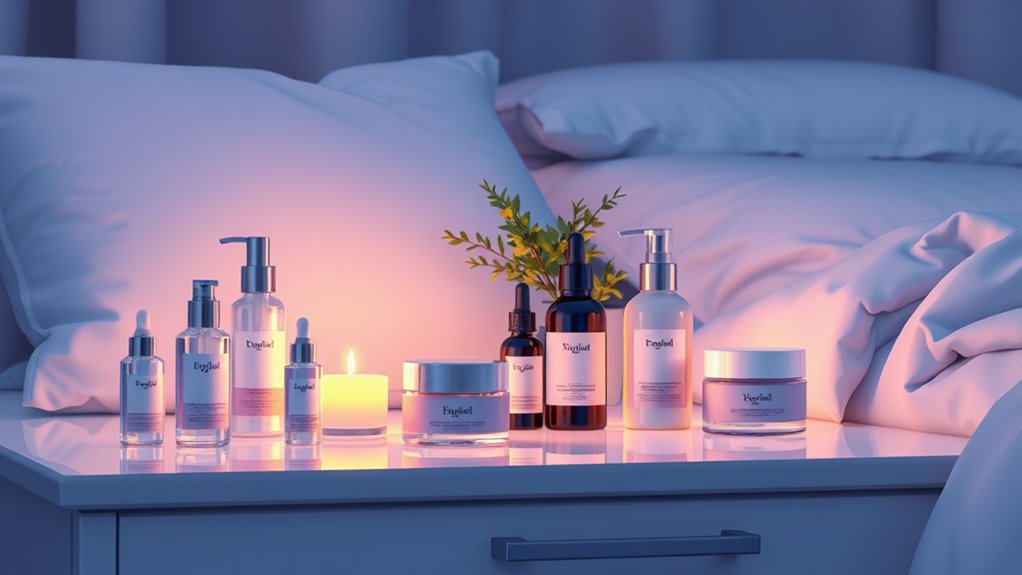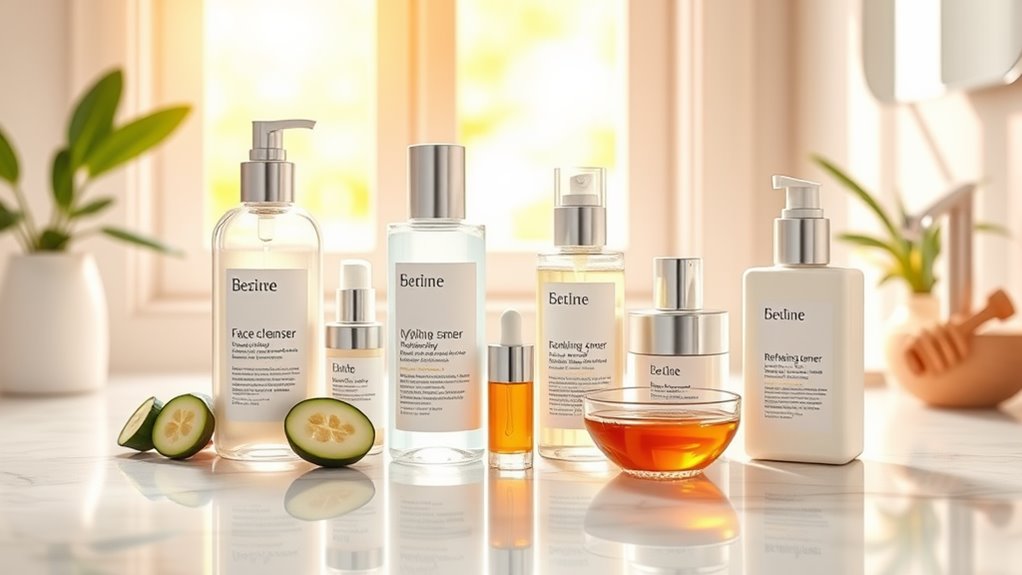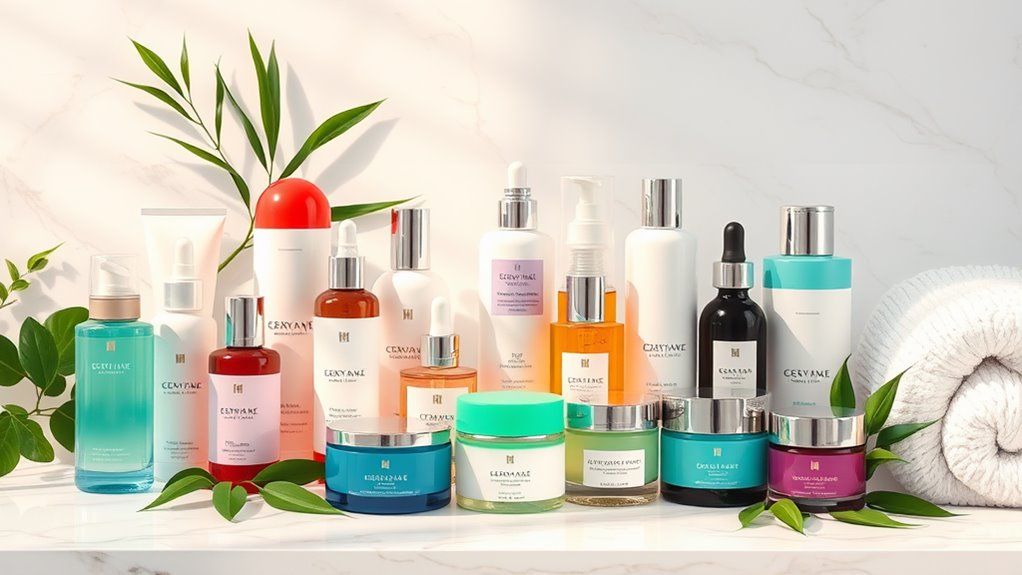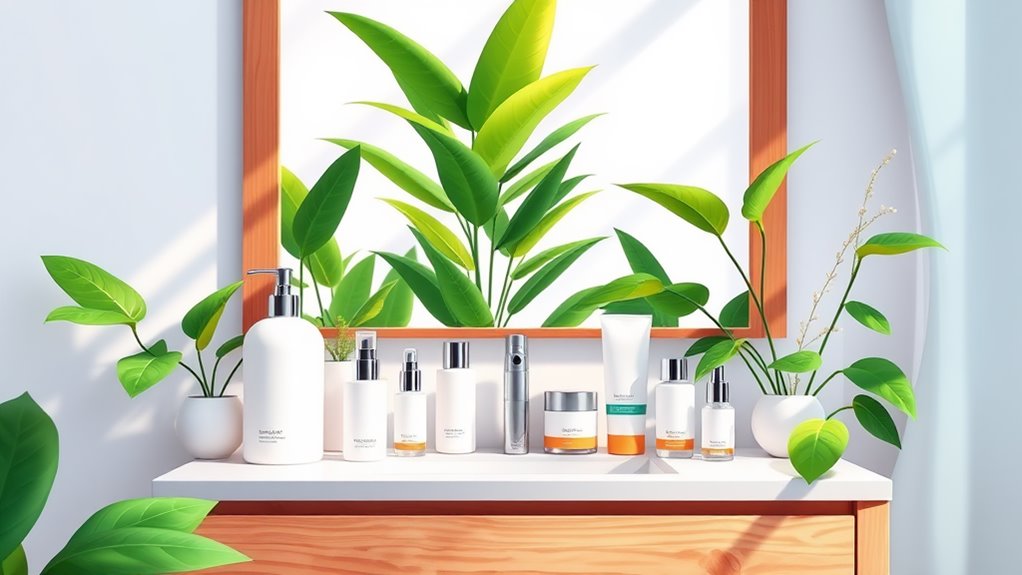Wake Up to Better Skin With This Night Routine
Are you ready to transform your skin while you sleep? A nighttime routine is essential for maintaining a healthy complexion. It’s not just about washing your face; it’s a multi-step process that can rejuvenate and repair your skin overnight. From cleansing to moisturizing, each step plays an important role. So, let’s explore how to craft the perfect night routine that will leave you waking up to a refreshed, radiant glow each morning.
Key Takeaways
- Start with a thorough cleanse to remove impurities and prepare your skin for treatments.
- Exfoliate regularly to promote cell turnover and achieve a smoother, more radiant complexion.
- Use targeted treatments with active ingredients to address specific skin concerns effectively.
- Moisturize to lock in hydration and support overnight skin repair and rejuvenation.
- Finish with a nourishing night cream or sleeping mask to enhance hydration and protect your skin while you sleep.
Understanding the Importance of a Nighttime Routine
As you wind down for the night, remember that a nighttime skincare routine is essential for maintaining healthy skin.
Your skin undergoes repair while you sleep, making night skincare a vital component of your beauty regimen. By implementing a consistent routine, you enhance your skin’s natural regenerative processes.
This is your opportunity to nourish and hydrate, allowing potent ingredients to work their magic uninterrupted. A well-crafted night skincare routine can address various concerns, from dryness to aging, ensuring you wake up refreshed. Additionally, incorporating natural ingredients that target dark spots can significantly improve your skin’s appearance over time.
Prioritizing this time allows you to create a sanctuary for your skin, setting the stage for peak health. Embrace the power of night skincare, and you’ll reveal your skin’s true potential night after night.
Step 1: Cleanse Your Skin Thoroughly
Cleansing your skin thoroughly is the essential first step in any effective nighttime skincare routine. At the end of the day, your skin is exposed to dirt, oil, and impurities that can clog pores and lead to breakouts.
Start by choosing a cleanser suited to your skin type—whether it’s gel, cream, or oil-based. Apply it gently in circular motions, ensuring you cover every area, including hard-to-reach spots. Rinse with lukewarm water to avoid stripping your skin’s natural moisture. Additionally, regular cleansing can help combat common daily habits that may accelerate skin aging.
Step 2: Exfoliate for Renewed Texture
Exfoliating your skin is essential for achieving a smoother, more radiant texture.
You can choose between physical and chemical exfoliants, each offering unique benefits. Additionally, be mindful of common eye care mistakes that can hinder your overall skincare routine and ensure you’re using products that are safe for the delicate eye area.
Benefits of Exfoliation
While you might think your skin looks great, incorporating exfoliation into your night routine can reveal a fresher, more radiant complexion. Exfoliation not only removes dead skin cells but also enhances your skin’s texture and tone. By doing this, you promote cell turnover, which can reduce the appearance of fine lines and dark spots. Here’s a quick overview of the benefits:
| Benefit | Description | Frequency |
|---|---|---|
| Smoother Texture | Removes rough patches | 2-3 times a week |
| Brighter Complexion | Unclogs pores for a luminous look | 2-3 times a week |
| Improved Absorption | Enhances product penetration | After exfoliating |
| Even Skin Tone | Diminishes discoloration | 1-2 times a week |
| Prevents Breakouts | Minimizes clogged pores | Weekly |
Elevate your routine and enjoy the transformation!
Types of Exfoliants
After understanding the benefits of exfoliation, it’s important to know the different types of exfoliants available.
You’ll typically encounter two main categories: physical and chemical exfoliants. Physical exfoliants use granules or tools to manually slough off dead skin cells, giving you immediate texture improvement. Think scrubs or brushes.
On the other hand, chemical exfoliants utilize acids or enzymes to dissolve dead skin without scrubbing, offering a gentler approach. Alpha hydroxy acids (AHAs) are great for dry skin, while beta hydroxy acids (BHAs) penetrate pores, making them ideal for oily or acne-prone skin.
Step 3: Apply Targeted Treatments
Now that you’ve exfoliated, it’s time to apply targeted treatments tailored to your skin’s needs.
Choose your treatment wisely, focusing on specific concerns like acne or dark spots.
Remember to apply them evenly and sparingly for the best results. Incorporating ingredients like scientifically-proven methods can significantly enhance the effectiveness of your treatments.
Choose Your Treatment Wisely
As you wind down for the night, applying targeted treatments can make a significant difference in your skin’s health.
Choose products that address your specific concerns—be it acne, hyperpigmentation, or fine lines. Look for active ingredients like salicylic acid, retinol, or hyaluronic acid, depending on your skin type and issues.
Understand the potency of each treatment; stronger isn’t always better. For instance, if you’re using retinol, start with a lower concentration to assess your skin’s response.
Remember, consistency is key, but so is listening to your skin. If irritation occurs, you may want to adjust your routine.
Apply Evenly and Sparingly
To maximize the effectiveness of your targeted treatments, apply them evenly and sparingly across your skin.
Take a small amount of product—think a pea-sized dot for each area—and use your fingertips to gently spread it. Focus on problem spots but make certain you don’t overload any single area.
This technique allows the active ingredients to penetrate deeply without overwhelming your skin, minimizing the risk of irritation. Make sure to blend well, so your skin absorbs the treatment fully.
Step 4: Moisturize for Hydration
Moisturizing is a crucial step in your night routine, as it locks in hydration and helps your skin repair itself while you sleep.
Choose a moisturizer that suits your skin type, whether it’s lightweight gel or a rich cream. Gently apply it using upward motions, ensuring even coverage across your face and neck. Focus on areas prone to dryness, allowing the product to penetrate deeply.
Incorporate ingredients like hyaluronic acid for moisture retention or ceramides for barrier support. Don’t forget to take into account your skin’s specific needs; adjust your formula seasonally as well.
This step not only nourishes your skin but also creates a protective layer, enhancing the effectiveness of the previous treatments and setting the stage for a rejuvenated complexion by morning.
Step 5: Protect Your Skin Overnight
After you’ve locked in moisture, it’s important to protect your skin overnight to maximize its recovery.
Using a quality night cream or sleeping mask can create a barrier, locking in hydration and preventing moisture loss while you sleep. Look for products rich in antioxidants and peptides, which help repair and rejuvenate your skin.
Don’t forget to apply a nourishing lip balm to keep your lips hydrated.
If you’re prone to breakouts, consider a targeted treatment to combat blemishes without disturbing your skin’s natural balance.
Finally, make sure your pillowcase is clean and made of a gentle fabric to avoid irritation.
Frequently Asked Questions
How Long Should a Nighttime Routine Take?
Your nighttime routine should ideally take about 20 to 30 minutes. This timeframe allows you to effectively cleanse, treat, and hydrate your skin, ensuring it gets the care it needs for maximum overnight recovery.
Can I Skip Cleansing if I’M Not Wearing Makeup?
You shouldn’t skip cleansing, even if you’re not wearing makeup. Dirt, oil, and pollutants accumulate throughout the day. A thorough cleanse guarantees your skin stays healthy and prepped for any treatments you apply afterward.
What if I Have Sensitive Skin?
If you have sensitive skin, prioritize gentle, fragrance-free products. You’ll want to test new products on a small area first and avoid harsh exfoliants. Consistency is key, so stick with a soothing routine that works for you.
Is It Necessary to Exfoliate Every Night?
You don’t need to exfoliate every night; in fact, it can irritate your skin. Instead, try exfoliating two to three times a week, adjusting based on how your skin responds for best results.
Can I Use the Same Products Every Night?
You can use the same products every night, but it’s wise to listen to your skin. If irritation occurs, consider adjusting your routine or incorporating different products to maintain balance and achieve ideal results.
Conclusion
By following this nighttime routine, you’re setting your skin up for success. Cleansing, exfoliating, and applying targeted treatments not only help address your specific concerns but also guarantee your complexion stays hydrated and healthy. Don’t underestimate the power of a good moisturizer and a nourishing night cream—they’re your skin’s best friends while you sleep. Embrace this routine, and you’ll wake up to a refreshed, radiant glow every morning, ready to take on the day!





